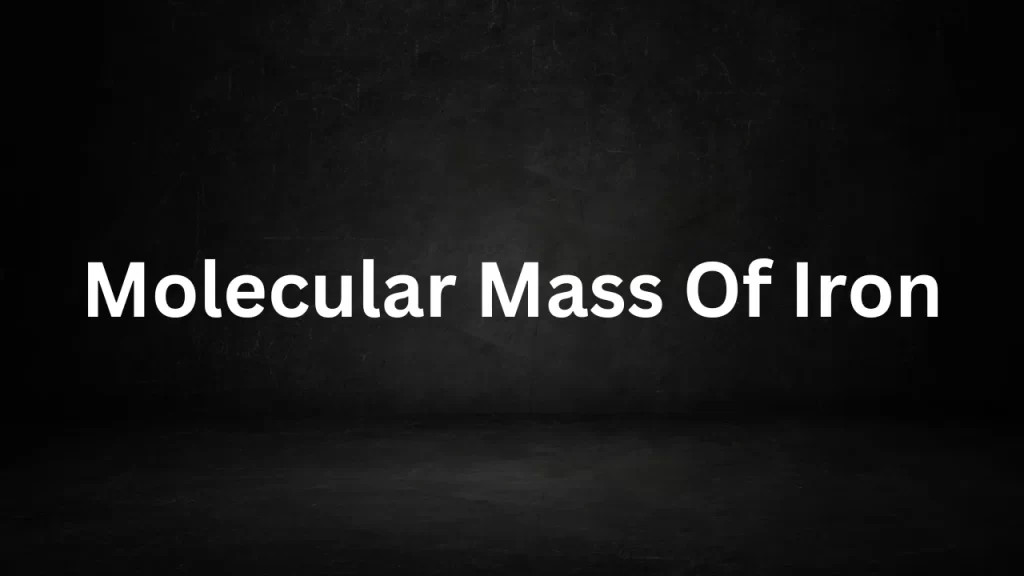Tag: iron iii chloride hexahydrate molecular weight
Molecular Mass Of Iron
Molecular Mass Of Iron: Iron, a metallic element with the chemical symbol Fe and atomic number 26, holds a prominent place in the world of science and industry.
Understanding the mole mass of iron is essential in various applications, from metallurgy to medicine. In this article, we will explore the molecular mass of iron, its significance, and its role in different fields.

Molecular Mass Of Iron
The Nature of Iron
Iron (Fe) is a transition metal known for its remarkable properties, including its high conductivity, malleability, and magnetic properties. It is one of the most abundant elements on Earth and is crucial for the functioning of living organisms.
Calculating the Molecular Mass
Unlike compounds, which consist of multiple elements, the molecular mass of an element is equivalent to its atomic mass. The atomic mass of iron (Fe) is approximately 55.845 atomic mass units (amu).
Significance of Iron’s Molecular Mass
- Metallurgy: Iron’s mole mass plays a pivotal role in metallurgy, where it is used to create various alloys, such as steel. The precise molecular mass is crucial in determining the alloy’s properties, such as strength and corrosion resistance.
- Chemical Reactions: In chemistry, the mole mass of iron is essential for stoichiometry and reaction calculations. It aids in determining reactant ratios and product yields in various chemical processes.
- Medicine: Iron is vital for human health, as it is a key component of hemoglobin, which transports oxygen in our blood. Knowledge of iron’s molecular mass is essential in medical diagnostics and treatments for iron-deficiency anemia.
- Industrial Applications: Iron and its compounds are used in diverse industrial applications, including manufacturing, construction, and electronics. Understanding the molecular mass is vital for quality control and process optimization.
- Geology and Earth Sciences: Iron is a significant component of Earth’s composition. Its molecular mass contributes to the study of geological processes, including the formation of minerals and rocks.
- Space Exploration: Iron is abundant in celestial bodies like Earth, the Moon, and Mars. Its molecular mass is relevant in the study of planetary geology and potential resource utilization in space exploration.
Conclusion
Iron, with its mole mass of approximately 55.845 atomic mass units (amu), is a versatile and indispensable element in various fields, from metallurgy to medicine, industry, and beyond. Its unique properties and abundance make it a cornerstone of human civilization and scientific discovery. As we continue to explore new frontiers and innovations, the molecular mass of iron remains a fundamental parameter in our understanding of the natural world and our technological advancements.
Read More
- Molecular Weight Of NH3
- Molecular Mass Of Methane
- Molecular Mass Of N2
- Molar Mass Of I
- Molecular Weight Of Cl
Frequently Asked Questions (FAQs) On Molecular Mass Of Iron
1. What is the molecular mass of iron?
The mole mass of iron (Fe) is approximately 55.845 atomic mass units (amu).
2. Is the molecular mass of iron the same as its atomic mass?
Yes, for elements like iron, the mole mass is the same as its atomic mass. The atomic mass represents the mass of one atom of iron, and in the case of iron, it’s approximately 55.845 amu.
3. Why is the molecular mass of iron significant in metallurgy?
The mole mass of iron is crucial in metallurgy because it influences the properties of iron alloys, such as steel. Engineers and metallurgists use this value to design and manufacture materials with specific mechanical properties.
4. How is the molecular mass of iron used in chemical reactions?
In chemistry, the mole mass of iron is essential for stoichiometry. It helps determine the amount of iron required in chemical reactions and the products’ yields.
5. What is the role of iron’s molecular mass in human health?
Iron is essential for human health, particularly in the form of hemoglobin, which transports oxygen in the blood. Knowledge of iron’s mole mass is important in medical diagnostics and treatment of conditions like iron-deficiency anemia.